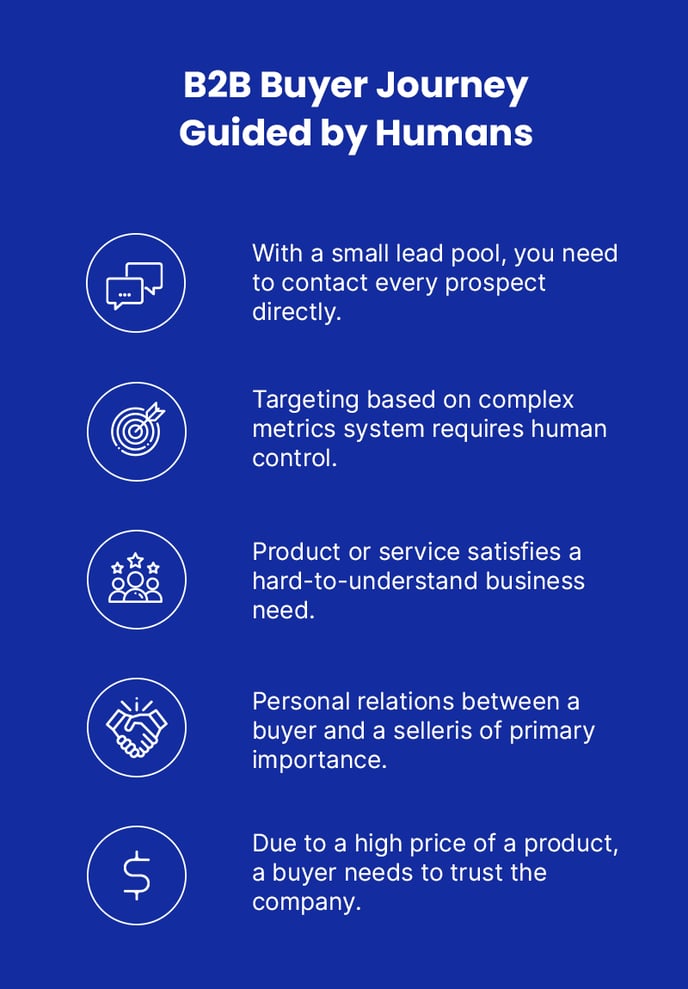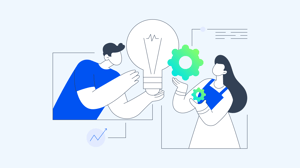How B2B Lead Generation is Becoming More Human
Over the past 20 years, business has become increasingly digitalized. New software appears on the market on a daily basis. These new programs enable us to automize working processes that used to take an enormous amount of time in the past. B2B lead generation is no exception here.
With the rise of the Internet, search engines and keywords, the buyer journey has changed significantly. Some marketing experts even claim that personal interactions are no longer necessary in this process. They wish to see B2B lead generation process as a solitary trip from a problem to a solution in a purely digital world.
New marketing techniques of pulling prospects into a sales funnel are automated. Although people manage these processes from backstage, they don’t contact the potential buyers directly. While this can be okay for B2C for a number of reasons, the lack of human connection for B2B can be damaging.

How B2C lead generation benefits from automation:
1. This business model has a large pool of potential customers compared to B2B. The “digital journey” makes it possible to save costs on the sales personnel. If a person finds your offer online, makes a purchase on your website with a credit card and then receives it from a drone, you save money on human labor.
2. The product/service of B2C is relatively cheap and easy to understand. As a result, most buyers don’t need seller assistance in making their decisions. In addition to that, people nowadays tend to rely more on customer reviews rather than on the “promises” of a sales team.
3. The selling process is short and emotions impact it significantly. Besides, it’s preferable to establish relations between a brand and a consumer rather than a seller and a buyer. The automation will enable you to create a more significant presence online, including social networks. As a result, you’ll pull your potential clients more efficiently.
4. Automation can provide micro-targeting based on demographic, psychographic and sociographic data, as well as a person’s behavior online. The collecting and processing of this information are more important than a conversation with leads who don’t fit your buyer persona.

Why B2B lead generation can’t efficiently work without “human” sellers
Above, we listed four reasons, why the digitalization of a buyer journey is a good idea for B2C. However, they don’t work for B2B, and here’s why.
Offer
Let’s begin with your product and service. Most B2C products and services are “obvious,” and people understand why they need to make a purchase. For example, companies selling pizza don’t need to rationalize why people need it. They merely have to explain why their pizza is the best choice, inflicting certain emotions in clients. For B2B, the situation is very different.
First, the need for your service or product isn’t always obvious, especially if it’s at the beginning of the lifecycle. For example, you just created new equipment that speeds up the work of a restaurant chef by 30%. Don’t expect that market will be ready for it. Above all, your potential buyers won’t even know about such a fantastic opportunity.
Second, even if your product or service isn’t new to the market, there’s no guarantee that your customer is looking for them on the Internet. Furthermore, they might not even realize their problems and needs. Third, if a company uses the product or service of your competitors, they won’t be looking for your offer on the web.
Summing up, there would be no digital journey (as marketers describe it) because people wouldn’t even start it. That’s why you need someone to reach out to your potential customers to explain why they need your product or service in the first place.

Leads
The pool of prospects is smaller, but the competition can be even more significant than that of B2C. As we mentioned above, the digital journey of a considerable number of your potential buyers hasn’t even started. On the other hand, there are plenty of leads who are searching ways to solve their problem on the Internet.
Can you control their quest? You can’t! And that’s the main drawback of a fully digital buyer journey. Your visitors left your website without leaving their email. Were they just a bad fit for you? Were they not interested? Or did they spot some mistake? You have no feedback.
This problem is especially crucial if you’ve just begun building your presence on the Internet and your search engine rankings are low. Still, you need your deals closed now. You can’t wait for your fully automated digital journey to settle.
Pulling works for fishing, when you have plenty of fish in the pool and a large net. However, when the number of your targets is small, you need to change your strategy and start hunting. You should engage with your leads directly and start the person-to-person conversation. And that’s what we call outbound prospecting.
Selling process
B2B’s selling process is much longer than that of B2C. And the decision-making isn’t emotion-driven, at least to a certain extent. We mentioned above the importance of a buyer’s attachment to the brand, rather than to a seller. The connection between a customer and a business matters a lot.
However, when it comes to B2B, the interpersonal relations weigh. And that’s pretty interesting, because the decision-making process, in this case, depends mostly on rational thinking. So, why is human contact so crucial for establishing cooperation between businesses?
Because much is at stake. The possible losses in case of a wrong decision include a colossal sum of money, time, and resources of a company, as well as reputation and even a job of the buyer. As a result, when people become representatives of a company in a purchasing process, they want to trust the seller.
People are more trusting when they can contact someone in person and see them face to face or hear them over the phone. Seeing a company’s website isn’t enough to ensure they are genuine. Any decision-maker in business knows that creating a beautiful image is a matter of hiring a good designer.
However, you can often read the expression on a person’s face or hear some changes in the voice. There’s this hard-to-explain “gut” feeling that tells you if your interlocutor is worth your trust.
To conclude, a business needs a good “human” representation to establish strong relations with other companies. You can attain it only if your sales representatives contact your leads in person. Without it, your company will be nothing more than a beautiful website among many others.
Targeting
Although targeting works excellent for B2B, there are specific differences from B2C. Have you ever suffered a significant bounce rate in your email send-outs? Have your SDRs ever told you that about one-third of people they reach out no longer work at the required companies? It means your contact list is out-of-date.
While inbound marketing efforts enable you to track the visitors of your website and score the leads, they’re still not enough to fill your pipeline. A B2B lead pool is much smaller than that of B2C. It makes every prospect exceptional and every name on your contact list extremely important. Targeting for B2B is much harder because key indicators can often change.
Here’s an example. You sell dresses, and your buyer persona is a 24-30-year-old female that graduated from a University. The young lady is single, lives in a city and takes interest in modern art. The metrics which inevitably would change are the relationship status and age. However, you’ll still have a couple of years if you target a 25-year-old.
If you search for a VP of Sales at companies with 1000+ employees, about one-fourth of your list will be out-of-date in just six months with many of the employees leaving the firm, promoted or fired. That’s why you need a constant human control of your targeting efforts for B2B.

Human face
Technology is fascinating and machines excel at tasks like analysis, data processing, and calculation. However, it’s our greatest belief that no software can replace a human in particular working processes, including B2B sales. If you want to succeed in cooperation with other companies, you need to build a good team and outsource some tasks to professionals.
Recently, we presented our vision on human labor at Future of Work Conference 2018. Our top management talked about artificial intelligence and the perspectives for young generations to find their place in the brand new world. They emphasized the importance of using technologies to augment our routine working processes.
Just like we use the energy to travel, we can use software to think faster and remember more. However, we should leverage our social skills and emotional intelligence to build a better world. In fact, these features will remain our principal distinction from machines for an extended period in the future.
A Few (Related) Sales Posts
 Featured image: Benefits of Marketing Automation for B2B Companies - Read full post: Top 3 Benefits of Marketing Automation for B2B Companies
Featured image: Benefits of Marketing Automation for B2B Companies - Read full post: Top 3 Benefits of Marketing Automation for B2B Companies
Top 3 Benefits of Marketing Automation for B2B Companies
 Read full post: Top B2B Lead Generation Hacks for Explosive Sales Growth
Read full post: Top B2B Lead Generation Hacks for Explosive Sales Growth
Top B2B Lead Generation Hacks for Explosive Sales Growth
 Read full post: 7 Ways to Scale B2B Lead Generation Through Marketing Automation
Read full post: 7 Ways to Scale B2B Lead Generation Through Marketing Automation